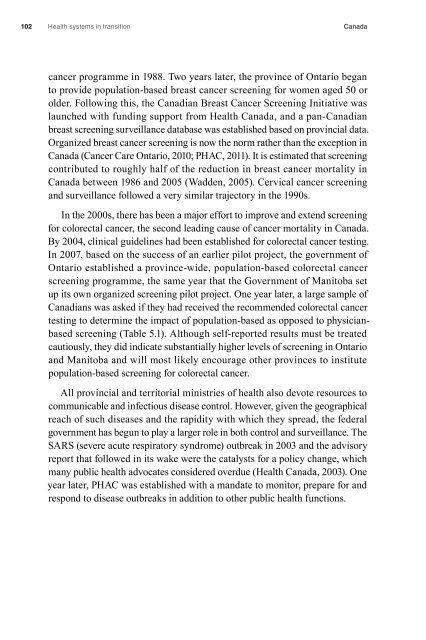Canada - World Health Organization Regional Office for Europe
Canada - World Health Organization Regional Office for Europe
Canada - World Health Organization Regional Office for Europe
Create successful ePaper yourself
Turn your PDF publications into a flip-book with our unique Google optimized e-Paper software.
102<br />
<strong>Health</strong> systems in transition <strong>Canada</strong><br />
cancer programme in 1988. Two years later, the province of Ontario began<br />
to provide population-based breast cancer screening <strong>for</strong> women aged 50 or<br />
older. Following this, the Canadian Breast Cancer Screening Initiative was<br />
launched with funding support from <strong>Health</strong> <strong>Canada</strong>, and a pan-Canadian<br />
breast screening surveillance database was established based on provincial data.<br />
Organized breast cancer screening is now the norm rather than the exception in<br />
<strong>Canada</strong> (Cancer Care Ontario, 2010; PHAC, 2011). It is estimated that screening<br />
contributed to roughly half of the reduction in breast cancer mortality in<br />
<strong>Canada</strong> between 1986 and 2005 (Wadden, 2005). Cervical cancer screening<br />
and surveillance followed a very similar trajectory in the 1990s.<br />
In the 2000s, there has been a major ef<strong>for</strong>t to improve and extend screening<br />
<strong>for</strong> colorectal cancer, the second leading cause of cancer mortality in <strong>Canada</strong>.<br />
By 2004, clinical guidelines had been established <strong>for</strong> colorectal cancer testing.<br />
In 2007, based on the success of an earlier pilot project, the government of<br />
Ontario established a province-wide, population-based colorectal cancer<br />
screening programme, the same year that the Government of Manitoba set<br />
up its own organized screening pilot project. One year later, a large sample of<br />
Canadians was asked if they had received the recommended colorectal cancer<br />
testing to determine the impact of population-based as opposed to physicianbased<br />
screening (Table 5.1). Although self-reported results must be treated<br />
cautiously, they did indicate substantially higher levels of screening in Ontario<br />
and Manitoba and will most likely encourage other provinces to institute<br />
population-based screening <strong>for</strong> colorectal cancer.<br />
All provincial and territorial ministries of health also devote resources to<br />
communicable and infectious disease control. However, given the geographical<br />
reach of such diseases and the rapidity with which they spread, the federal<br />
government has begun to play a larger role in both control and surveillance. The<br />
SARS (severe acute respiratory syndrome) outbreak in 2003 and the advisory<br />
report that followed in its wake were the catalysts <strong>for</strong> a policy change, which<br />
many public health advocates considered overdue (<strong>Health</strong> <strong>Canada</strong>, 2003). One<br />
year later, PHAC was established with a mandate to monitor, prepare <strong>for</strong> and<br />
respond to disease outbreaks in addition to other public health functions.
















